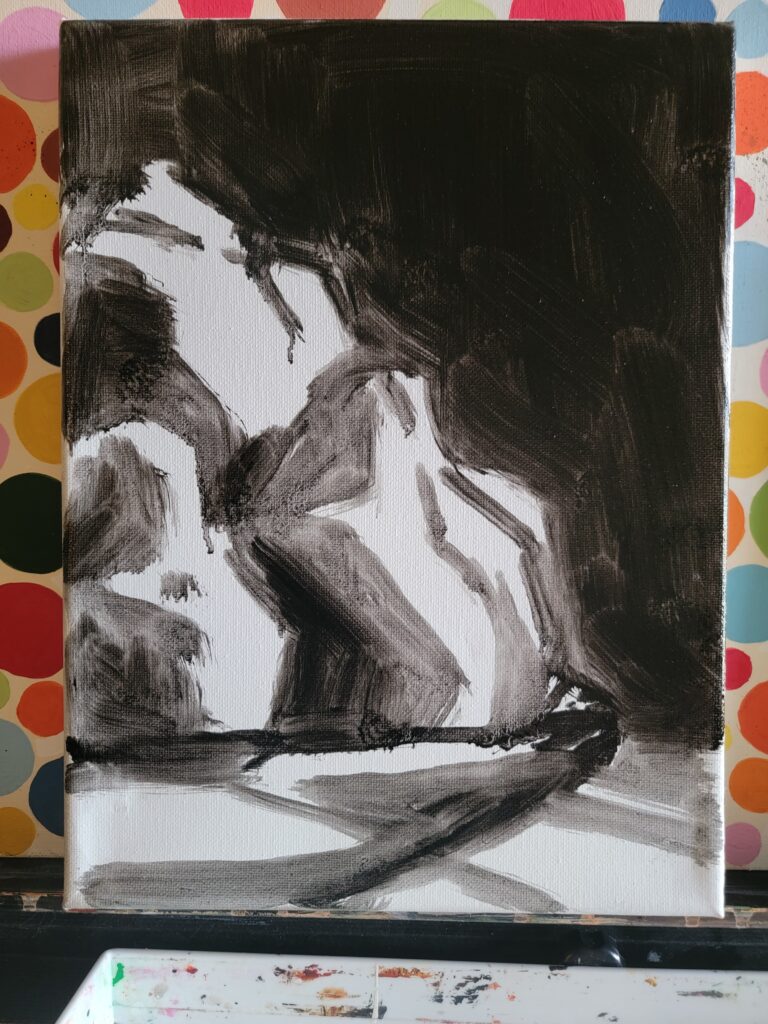I often find myself at a crossroads, Eager to improve at painting but feeling overwhelmed as soon as I am in front of my easel. the canvas suddenly seems enormous, and I am unable to fill it. What’s more, the reference image starts to reveal far more colors than I initially saw, and I find myself unable to mix them properly. This leads me to doubt whether I’m truly capable of painting. And so, I put down my brush and tell myself that I will come back to it some later time when I have more time to meticulously plan each. and. every. single. move. which, by the way never happens.
I realized that if I keep waiting for the perfect moment, I’ll never progress. So, I made this commitment to continue this painting journey whether or not I am ready. Instead of letting these doubts hold me back! And so I decided to go back to basics and start from the beginning AND start right. To heck with perfection– this time I am doing this whether I am ready or not.
BLACK AND WHITE!
This is what I wanted to paint.
Pairs Fruit Bowl of Black by ClaudiaWollesen

Black-and-white practice allows me to regroup since it strips away the complexities of color, allowing me to concentrate on other fundamentals of painting, taking it by stride, almost. I like to think I am smart I am by compartmentalizing colors, compositions, value, contrast, and texture, but I know that the next painting after this will have to have color. Hopefully, this practice helps me on my next one because we know that’s how that always works!
I could write here why black-and-white practice is important for beginners but I’m not really a beginner. I am someone who is stuck in a limbo going on long hiatuses before having a burst of artistic energy and then vomiting all those idea in a poor unsuspecting canvas and then getting disappointed that my ideas never quite match what my skills can achieve. What I truly want is to be consistent, and I’m hoping this blog will help me achieve that.
My Setup

My setup is simple, a canvas, a reference image, and paint on my palette.
My Tools

My tools are a collection of ALL the art supply I’ve accumulated over the years. Nothing fancy– just long handled-brushes and palette knives.
My oil paints are Artist’s Loft brand from Michaels, and I use Gamblin Gamsol Odorless Mineral Spirits to clean off my brushes, but only before putting them away. Oil paint is surprisingly easy to clean off using a combination of paper towel and old rags.
The Pallet

I mixed different shades of gray to make it easier to paint varying values, but I have a habit of mixing paint directly on the canvas, so I didn’t prepare a lot in advance. While this approach gives me flexibility and allows for spontaneous adjustments, it also means I sometimes struggle to maintain consistency across the painting. This is something I hope to outgrow in the future

In the first phase of painting, I start by mapping out my lights and darks. Normally, I like to stain my canvas beforehand, but since this is a black-and-white painting, I skipped that step. I don’t usually sketch beforehand; instead, I go straight to painting, using heavily diluted paint to “sketch” my composition directly on the canvas. I use black for shadows and leave the canvas white for the lights. I’m not sure if this is considered good practice, but it’s the method that works for me.

I want to preface this by saying that this painting took a couple of days to finish due to various factors, including general laziness, procrastination, and life’s demands. I also scheduled this painting with the goal of working on it for just one hour a day. By the time I reached this phase, at least three days had passed since I started. Taking long breaks and working in short bursts helps me avoid overdoing and overthinking, which are challenges I often face. This approach allows me to keep a fresh perspective and maintain my focus without burning out.

FINAL PHASE! This is a week after I started.
Overall, I’m satisfied with the result, though I recognize there’s still much to learn. Looking at the finished piece now, I still feel it isn’t quite good enough, which may be a personal issue. However, I’ve discovered that having a set schedule for painting—rather than waiting for inspiration to strike—works better for me. Establishing a routine might be a key step toward achieving greater consistency in my work. While I still have a long way to go, I’m hopeful that sticking to a structured approach will help me grow as an artist and make steady progress on my creative journey.
What strategies or routines have you found effective in overcoming procrastination and maintaining consistency in your creative work? Share your experiences and tips to help others on their artistic journey. Thank you for being here!
